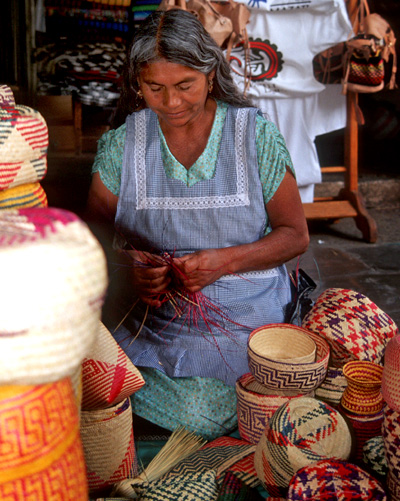
Francisca García Peralta around 1994
In Oaxaca city, through Mercado Juárez's open portal doors, I spot a young indigenous woman, maybe twenty-five years of age, sitting next to a large pile of polychrome straw baskets, fashioning a basket with her fingers.
This is Francisca García Peralta, from San Luis Amatlán, Oaxaca, a small village in the mountains six miles northeast of Miahuatlán, which by road lies about sixty miles south of Oaxaca City. Since indigenous women in this area sometime only understand their native language, at first I speak very slow and simple Spanish with Francisca, but immediately I hear that she speaks Spanish much better than I. In fact, her quick wit, humor, and self confidence are very impressive. She's fun to talk to, and before long we're laughing and kidding one another like best friends. Francisca's charming personality keeps you from noticing how badly her eyes are crossed.

Francisca García Peralta, from San Luis Amatlán, Oaxaca, weaving in Oaxaca City's Mercado Juárez, in 1994
"My whole village makes straw baskets," Francisca begins, never pausing with her work. "I began weaving baskets when I was ten. Like everyone else, my grandparents taught me everything, not just how to weave fibers together with my fingers, but also all the designs. You get these designs in your head, and then they're ready to go here on the baskets. You just figure out which design you want to work with and then you do it. There are many, many designs in my head -- all those you see here before us, and many others. And they all have names.

Basket weaver at the Benito Juarez market in the city of Oaxaca, twenty years later in 2014; could even be Francisca; copyright free image courtesy of Friends of Oaxacan Folk Art, made available through Wikimedia Commons.
There's the pescadito (little fish), the paragua (umbrella), the carritos (little carts), the llave (key), the cohete (rocket), the platillo (saucer), the tres palmas (three palms), the redecilla (small net), the cadenita (little chain), and of course there's the cruz (cross). There are so many. When we say these names to one another, everything is clear, we understand everything."
I remark that it must be wonderful knowing so much about something, to know "tan mucho, mucho... " but before I end with my second "mucho" she chimes in laughing "tan poco, poco... " -- "so little, so little... "
I ask if there's a danger that in her village this ancient knowledge will ever be lost because young people leave for the cities to work in stores and offices.
"No chance!" she shoots back. "That's because our young people never can study. We don't know letters. We haven't gone to school. We were... well, we are poor. That's why we make baskets. We don't go to work in offices and stores because we don't know how to. Well, that's it. That's why we're here with these baskets."
Francisca's face has become troubled. She takes a deep breath, forces a smile, and launches onto a different subject.
"The straw we use comes from a kind of tree, a palm, that grows in a town called Sola de Vega. We buy straw by the pinca. It's ten pincas, twenty, thirty pincas, until 100 pincas, and that costs U.S. $6.67; 100 pincas is $6.67. For a basket we need maybe seven or eight pincas. Then there's dyeing. We get the water boiling, put in the dye powder, add the palm, stir with a paddle, and then it's dyed. The dye is bought in a store, and we don't know where it comes from. Just that it's awfully expensive. A tiny soup-spoon of it costs U.S. $1.67, so if we want two colors, that's $3.33! And if you want yellow, or rose color, that's $5.00. If you want blue, it's $5.00, if it's green, $6.66. So, you see, with the cost of straw and dye, and then transporting the baskets all the way from San Luis to here, it becomes a lot of money."
"On top of that, it takes so much time," Francisca continues. "This little canister here (one foot tall polychrome, with top), you begin today and you end tomorrow. That big one there needs three days. You begin today, then there's tomorrow, and then, sometime the next day, you end. It takes time because it's by hand. That's the truth. Because, you have to worry with the design, get all the weaving right, and finish it so that it stays together."
"But then the people don't want to pay us much money. This little canister took a day to make but it only brings two and a half dollars, and that big one five to six dollars. Yes, as little as five dollars for three days of work. That's because, if we ask for over six dollars, people come, they look, and they don't take anything. It's because they don't understand how much work in involved. They just say, 'Oh, six dollars is very expensive,' and they walk away. They just don't know what it costs to make these, and how much time it takes. Well, then here we are, not knowing how to do any other kind of work... "
I ask if weaving baskets tires the body.
"Yes, and when we work all day long, our hands, our entire arms and shoulders, how they burn. And then if we go bathe in cold water, what awful cramps we get. But we take care of our hands, and when they burn, we wrap them in warm, moist rags, and never use cold water on them."